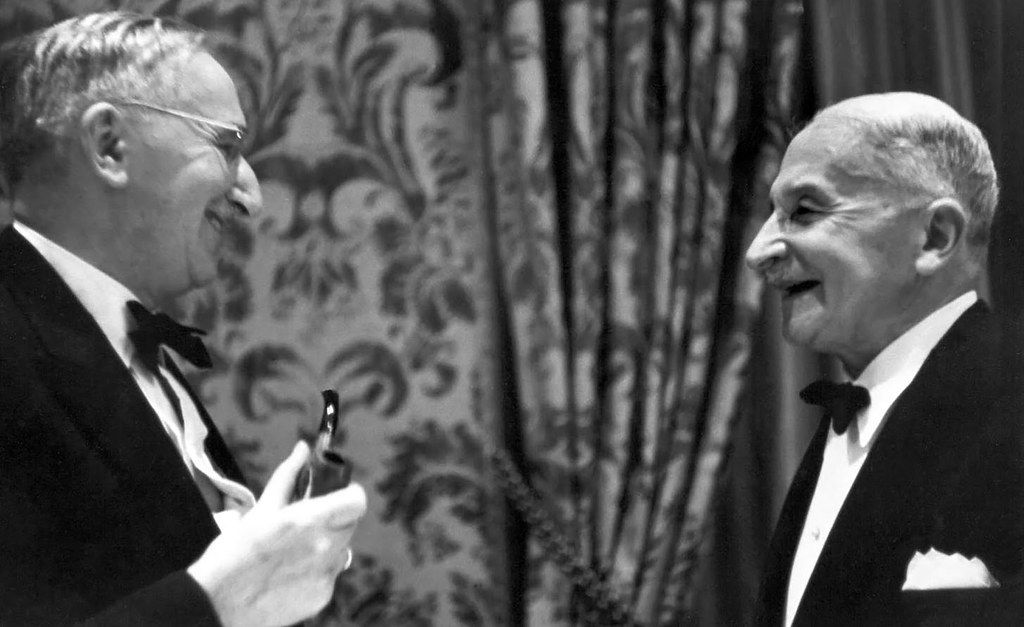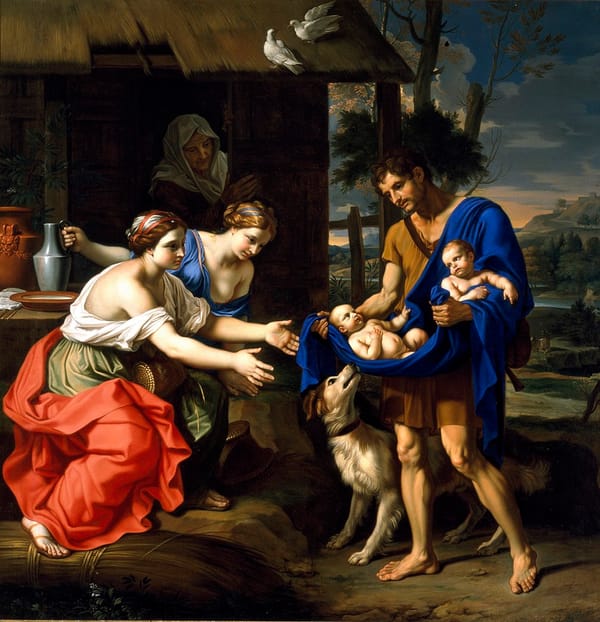No, Libertarians Cannot "Reclaim" Liberalism

In 2021 the libertarian representative Justin Amash “reclaim[ed] the word ‘liberal’ for classical liberalism” in a tweet. This wasn’t the first reclamation. George Mason University economist Daniel Klein assembled a “statement of no surrender on the word ‘liberal’” with several hundred signatories, drawing a line in the sand against associating liberalism with increasing “governmentalization.” Indeed it’s common for classical liberals and libertarians to bemoan how the L-word was taken from them by Franklin D. Roosevelt and his New Deal liberals. This call to reclaim “liberal” will only grow now that the Libertarian Party has been fully taken over by rightwing extremists, potentially poisoning “libertarian” for years to come.
The trouble is social liberalism—or left liberalism—has roots stretching back to the earliest days of the liberal era and clear lines can be drawn from these origins to the present liberal scene. Classical liberals do not have a unique claim to an authentic liberal heritage, and their attempts to claim the moniker for themselves threaten to unravel what ties liberals together and undermines their united front against the genuinely antiliberal threat of rightwing authoritarianism.
Let’s think of social liberalism as a kind of opposite of laissez-faire: any liberalism that centers social justice—improving the plight of the poor and other marginalized groups—and allows a wide scope for government policy to influence economic outcomes by redistribution, regulation, or public investment. This contrasts with the classical liberal view, which favors limiting government redistribution and intervention in economic life as much as possible, and often—though not always—opposes social justice in theory and in practice.
The father of liberal capitalism
Few thinkers rank as highly in the liberal pantheon as Adam Smith, the Scottish moral philosopher and father of economics, if not capitalism itself. Beloved of classical liberals for the laissez-faire elegance of his “system of natural liberty” and maligned by the left for his alleged valorization of selfishness, the real Adam Smith was far more complicated—and interesting. A gusher of revisionist Smith scholarship since the turn of the century has toppled the image of the laissez-faire Smith.
Smith was particularly concerned with inequality of power and the welfare of workers, affirming that all legislation in favor of workers was “always just and equitable.” And Smith was keenly mistrustful of merchants and business owners, alerting his audience—legislators and their advisors—that associations of merchants and business owners always involve conspiracies against the public.
Smith asserted “It is but equity, besides, that they who feed, cloath and lodge the whole body of the people, should have such a share of the produce of their own labour as to be themselves tolerably well fed, cloathed and lodged.” Samuel Fleischacker has argued that the apparently parsimonious “system of natural liberty” affords ample room for a welfare state among the limited duties of the sovereign. Fleischacker is well within the mainstream of Smith interpretation, but it’s worth noting that Smith also provides a theoretical kernel for more ambitious projects like the capabilities approach, a framework pioneered by the Smith-inspired social liberals Martha Nussbaum and Amartya Sen that goes beyond formal rights and equality to assess what an individual can effectively do and be in their particular social context. Indeed, I have argued that even more radical uses can be made of Smith.
Forgotten liberals
Smith, who died before “liberal” became a noun, was not the only liberal thinker to defy the laissez-faire mold of classical liberalism. In Economic Sentiments: Adam Smith, Condorcet, and the Enlightenment Emma Rothschild has noted a similar view of government provision for the poor in Smith’s French contemporary, the Marquis de Condorcet. For Condorcet, “[t]hat all members of society should have an assured subsistence each season, each year, and wherever they live; that those who live on their wages, above all, should be able to buy the subsistence they need …” was a “duty of justice.” Condorcet took this principle to advocate for the kind of social insurance scheme that would gain greater credence under the “New Liberalism” of the turn of the 20th century.
Early French liberals like Jean-Baptiste Say and Jean Charles Léonard Simonde de Sismondi explicitly advocated government intervention. Say really was a laissez-faire liberal, yet acknowledged a government could intervene based on public need. These were exceptions for Say, but he approached such exceptions pragmatically. “The grand mischiefs of authoritative interference proceed not from occasional exceptions to establish [sic] maxims, but from false ideas of the nature of things, and the false maxims built upon them.” Beyond this, Say favored an array of public works, again determined pragmatically, his examples typically being infrastructure like canals and bridges. Public primary education was justified in order to “civilize the lower orders” and to open up opportunities to them. Institutions of higher learning could be warranted as a kind of public work. Finally, Say praised as “noble and excellent institutions of public benevolence” public industry ventures that hired invalids and veterans and, notably, perfectly capable people who have been displaced by economic churn and innovation.
Say’s contemporary rival, Sismondi, provides an illuminating contrast. Sismondi would introduce the concept of proletarian class struggle later expounded by Marx. Sismondi warned of widening economic inequality and impoverishment inherently caused by industrial capitalism. The poor, for Sismondi, must be the focus of the legislator’s efforts for reasons of justice, economics, and political stability. “On whatever side we look, the same lesson meets us everywhere, protect the poor, and ought to be the most important study of the legislator and of the government.” In support of this priority, he advocated for workers to hold ownership shares of their firms, unemployment insurance, a progressive income tax, and for regulations on working hours and wages. These policies, proposed in the cradle of liberalism, would go on to form the backbone of the liberal welfare state.
It’s fair to ask whether Sismondi really counts as a liberal given his emphasis on class conflict and his skepticism about economic innovation, yet he explicitly identified as a liberal republican and was an occasional participant in Madame de Staël’s salon, the beating heart of early 19th century French liberalism. Sismondi advocated for the basic liberal freedoms of the press, association, the rule of law, and so on.
The celebrated liberal Alexis de Tocqueville would later sound similar warnings of growing inequality and the emergence of an “industrial aristocracy.” Public charity would be necessary to prevent the brutalization of workers. Far from shrinking government to a size suitable for bathtime murder, the state itself must be powerful. He notes in Democracy in America, “It is at once necessary and desirable that the central power that directs a democratic people be active and powerful. There is no question of rendering it weak or indolent, but only of preventing it from abusing its agility and force.”
Nor is this merely a French phenomenon. John Stuart Mill would usually be the first example of a “classical liberal” who advocated a large role for government in economic affairs and in pursuit of social justice, even advancing a kind of liberal socialism. Like Condorcet before him, Mill advocated for the equal rights of women, and indeed much of his intellectual work was profoundly influenced—or even co-developed—with his partner Harriet Taylor. Mill is sometimes seen as the turning point of liberalism from strict laissez-faire to interventionism, but the liberals discussed above show he was late to the party.
Mill was innovative but ultimately continuous with the liberal tradition. Wilhelm von Humboldt was a genuinely laissez-faire liberal who had little interest in the plight of workers but whose evocations of fully developing the unique potential in each individual in a free society inspired Mill. Mill would take this vision and democratize it, seeing instead a
well-paid and affluent body of labourers; no enormous fortunes, except what were earned and accumulated during a single lifetime; but a much larger body of persons than at present, not only exempt from the coarser toils, but with sufficient leisure, both physical and mental, to cultivate freely the graces of life.
This version of liberalism—a society of broad-based material abundance supporting the free development of the individual’s powers and diverse cultural exploration—more closely resembled the welfarist New Liberalism of the United Kingdom and American New Deal liberalism than the classical liberalism of sharply limited government.
My claim is not that there were no laissez-faire liberals. There certainly were. But from the very beginning there were liberals who were neither property rights absolutists nor nightwatchman minarchists who would restrict the functions of the state to national defense, courts, and police. And there were liberals who were particularly concerned with the poor and oppressed and would empower governments to address their plight through regulation of enterprise and/or economic redistribution.
Liberals against reaction
Thus the advent of the New Liberals around the end of the 19th century and the launch of the progressive era of welfare states and government intervention was neither a betrayal of liberal values nor a hostile takeover of the moniker. It was the natural divergence of alternative branches of the liberal tradition. It’s important to reassess this history because liberalism around the globe faces a crisis of self-confidence and self-awareness in the face of resurgent rightwing authoritarianism.
The move by classical liberals to distance themselves from left liberals or to “reclaim” liberalism spawns from libertarian-conservative “fusionism”—the not unreasonable response to a global threat from the communist left in the 20th century. Conservatives have been fellow travelers with classical liberals and valued allies against creeping socialism ever since.
But the rightward orientation of classical liberalism gave intellectual cover to an increasing commitment to covert racist politics on the right, beginning at the latest with Nixon’s Southern strategy and growing through the rise of the Evangelical and Tea Party movements until it tipped over into overt racism with Trump. The dog whistles were accompanied by antidemocratic politics aimed at limiting the electoral power of Blacks and other minorities. This again ripened into antidemocratic autocracy with Trump’s disdain for fig leaves.
Classical liberalism has always had a troubled relationship with democracy, harboring an abiding fear of ignorant or vicious majorities voting away individual rights. Despite being ahead of virtually every other group on racial justice issues like drug decriminalization and mass incarceration, libertarians have an unsavory history on race, with opposition to civil rights legislation and desegregation and strong racist currents in the Ron Paul wing of the movement. The libertarian to alt-right pipeline merits the discussion it receives.
The advent of Trump split the classical liberal camp along a bright line. Those on one side regarded Trump and his GOP with horror. Those on the other side largely saw nothing out of the ordinary, and continued to view both sides as equally bad. Trump was just another flavor of statism, and not any more of a threat to cherished norms and institutions than Barack Obama or Hillary Clinton.
The threat of Marxist-Leninism was genuine for much of the 20th century, both geopolitically in the form of the USSR and Maoist China, and culturally in the bizarre popularity of Soviet communism among a certain intellectual set. But the increasingly popular socialism of today is on the whole democratic, and even adjacent to liberalism. Popular democratic socialists like Alexandria Ocasio-Cortez and Bernie Sanders do not advocate central planning, which is the socialist institution most directly at odds with liberal values of individual autonomy and freedom to better one’s fortunes. Ocasio-Cortez endorses the profoundly liberal YIMBY movement for abundant housing. Sanders’s commitment to the liberal democratic order is plain to see in his address on Putin’s invasion of Ukraine. This is not to say that Sanders or Ocasio-Cortez are really liberal or that they aren’t truly socialist. Instead, the mainstream of socialism in America has simply moved in a liberal direction while that of conservatism has begun to diverge from liberal democracy.
By revisiting some of these historical highlights, classical liberals can recalibrate their orientation in today’s politics by understanding that progressive ideas have always had a place in the liberal tradition. Edmund Fawcett, an alumnus of The Economist and author of Liberalism: the Life of an Idea, has suggested that liberalism is guided by four broad impulses.
Amid the ceaseless change of capitalist modernity, the first liberals sought durable new ways to secure ethical and political stability. That liberal search, then as now, was guided by four broad ideas: acceptance that moral and material conflict in society cannot be expunged, only contained and perhaps in fruitful ways tamed; hostility to unchecked power, be it political, economic or social; faith that social ills can be cured and that human life can be made better; and law-backed respect by state and society for people’s lives and projects, whatever they believe and whoever they are.
Reflecting on these four ideas in our present political moment, it’s clear that the classical and social wings of the liberal tradition have more in common than they think, and strong reasons to see the authoritarian right as the greatest threat to their shared values.
Liberals, social and classical, believe in hashing out their differences again and again in representative government, jockeying for political power to advance their values even as they make compromises with the other party. The January 6th insurrection revealed that the authoritarian right doesn’t even hold the peaceful transfer of power sacred.
Social and classical liberals both oppose entrenched power, merely differing over which threats are the most pressing: corporate power and economic inequality, or government bureaucracy and heavy-handed regulators. Right-wing authoritarians stand for nothing so much as reinforcing the traditional dominance of the white and male capitalist class.
Classical liberals and progressives both have faith that social and economic progress are possible, that life can be made better for everyone, and further that all kinds of people are worthy of dignity, and a chance to flourish that should be acknowledged and protected by the state. The authoritarian right believes in progress in the form of economic growth, but jealously guards against the advancement of women and racial minorities. The reaction in “reactionary” is precisely that against the relative loss of social standing of straight, white, Christian men. And the Trumpist attitude toward the dignity and flourishing of Blacks, of women, of immigrants, and of gender and sexual minorities is vividly summed up by the observation that “the cruelty is the point.”
Social and classical liberals are estranged cousins, overdue for rapprochement in light of the reactionary threat.




